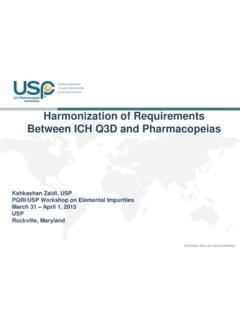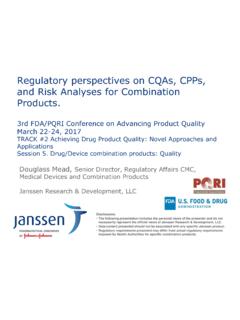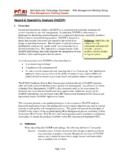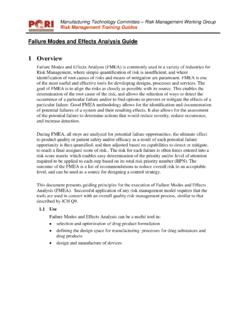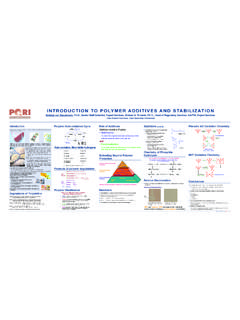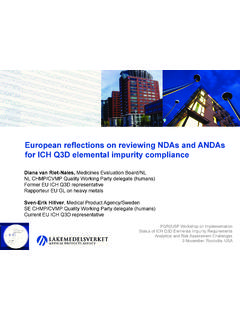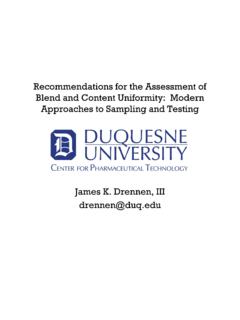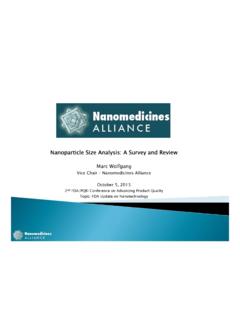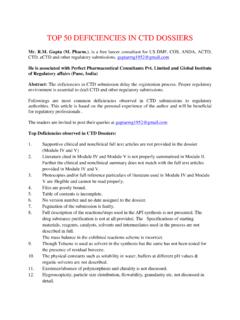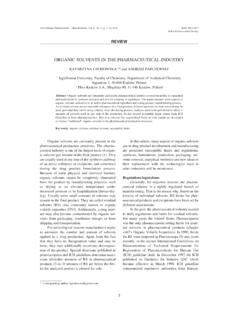Transcription of CMC Regulatory Considerations for …
1 CMC Regulatory Considerations for oligonucleotide drug Products: FDA Perspective Mohan Sapru, , CMC Lead for Cardiovascular and Renal Products Office of New drug Products Member, Emerging Technology Team (ETT). Office of Pharmaceutical Quality, CDER, FDA. OVERVIEW. oligonucleotide -Based Therapeutics: Promises and Challenges Synthetic Oligonucleotides: Structural Aspects - Antisense Oligonucleotides - Double-Stranded Small Interfering RNAs (siRNAs). - Chemical Modifications of Oligonucleotides - oligonucleotide Structure-Related Safety Considerations Synthetic Oligonucleotides: Major Regulatory Aspects - Regulatory Challenges - General CMC Considerations - oligonucleotide -Specific CMC Considerations 2.
2 Therapeutic Oligonucleotides - Exert effects through suppression of, or interference with mRNA. translation, immune stimulation, protein binding, or through induction of exon skipping - Can target a broad range of mRNAs (encode all cellular proteins), including protein targets that are considered undruggable by small molecule or protein therapeutics - An evolving class of therapeutic agents that present unique scientific and Regulatory challenges - Synthetic therapeutic oligonucleotides (in theory no potential for incorporation into the chromatin): Regulated by CDER, FDA. - Vector-based or promoter-driven oligonucleotides: Regulated by 3.
3 CBER, FDA. Synthetic Antisense Oligonucleotides: Structural Aspects Usually consist of 15-20 unmodified or chemically modified nucleotides (complementary to target mRNA sequence). Unmodified oligonucleotides are rapidly degraded by nucleases Chemically modified ribonucleotides are used to protect against nuclease degradation, improve target affinity and delivery to the intended target/tissue/region Antisense Technology Challenges: Nuclease Degradation, Stabilization, Targeted Delivery, Off-target Effects, and Toxicity 4. Commonly Used Antisense oligonucleotide Modifications Phosphate backbone: One of the oxygen atoms in the phosphate moiety replaced by sulfur ( oligonucleotide phosphorothioate).
4 Desirable effects: Nuclease resistance Undesirable effects at higher doses: Probability of off-target effects (binding to heparin-binding proteins). Ribonucleotide modifications (2' position of the ribose): 2'-O-methyl 2'O-methoxy-ethyl Morpholino Modification: The ribose is replaced by a morpholino moiety and 5. phosphoroamidate Use of Both Phosphate Backbone, and 2' Ribose Modifications Sodium 2'-O-methyl-phosphorothioate oligoribonucleotide (partial structure). Lower Toxicity?; Higher Target Affinity oligonucleotide Conjugates (for improved pharmacokinetic properties). - The covalent attachment of various ligands designed to improve bio- distribution and cellular uptake or targeting of specific tissues - Attached ligands: peptides, proteins, carbohydrates, aptamers and small molecules, including cholesterol, tocopherol or folic acid Example: N-Acetylgalactosamine (GalNAc) conjugates: reduced toxicity, improved potency/PK properties, lower off-target activity 6.
5 Overlapping CMC and Toxicology Review Considerations Direct relationship between oligonucleotide structure/modifications and toxicity and safety liabilities Example: Phosphorothioate (PS) backbone modification used to protect against rapid degradation by nucleases Phosphorothioate Antisense Oligonucleotides: - Sequence-independent, but length-dependent binding to various cellular proteins (heparin-binding molecules). - Phosphorothioate modification-linked thrombocytopenia 7. Phosphorothioate (PS) Modification-Linked Platelet Activation PS modification-linked thrombocytopenia mechanism not well understood * Based on recent studies PS-modified (not unmodified).
6 Oligonucleotides bind to platelet-specific collagen receptor glycoprotein VI (GPVI). Selective Binding Tyrosine Activation ROS Production *Flierl, et al. Journal of Experimental Medicine (2015): 129-137. 8. Regulatory Challenges No ICH or FDA Regulatory guidelines that specifically address the quality expectations/standards for oligonucleotide products oligonucleotide Diversity: Single stranded antisense, splice modulators, aptamers and immunological modulators, and double stranded siRNAs (that function by RNAi mechanism). Unique mechanisms of action with diverse toxicology profiles/concerns No consensus about impurity identification and qualification thresholds Impurity characterizing challenges: - Most exist as mixtures of closely related components - Some impurities are largely intact parent oligonucleotide cross-linked to another molecule of the parent oligonucleotide - Precision of analytical methods to adequately resolve impurities 9.
7 Review Considerations for Synthetic Oligonucleotides: Current Practices CFRs concerning CMC information apply: INDs: 21 CFR, part (a) (7); NDAs: 21 CFR, part (d) (1). - to ensure the proper identity, strength or potency, quality, and purity Despite their large size, synthetic oligonucleotide drugs are considered more similar to small molecule drugs than biologics in that they are manufactured by solid-phase chemical synthesis FDA's quality-related guidances for submission of INDs, NDAs or supplements are applicable--- graded nature of CMC information needed ICH guidances covering drug substance and drug product stability, analytical method validation, specifications, GMP risk management, pharmaceutical development/quality system.
8 And development and manufacture of drug substance are applicable 10. Review Considerations for Synthetic Oligonucleotides: Current Practices Confusion about whether USP Salt Policy applies to salt oligonucleotide drugs, partly because oligonucleotides (approx. molecular mass: 7000 to 8000) are not perceived as small molecules Based on antisense oligonucleotide structure, design and mechanism of action, the salt counterion does not play a critical role in mediating mode of action USP Salt Policy and FDA guidance Naming the drug Products Containing Salt drug Substances (20125) is applicable to synthetic oligonucleotide drugs ICH Q3C(R6) and ICH Q3D, the guidelines that cover residual solvents, and elemental impurities, respectively, are applicable to oligonucleotide products 11.
9 Synthetic oligonucleotide -Specific Review Considerations Identity: Determination of oligonucleotide sequence API Designation: Based on current availability of : a) refined analytical tools for structural characterization and resolution of different oligonucleotide species, and b) precisely controlled method for solid- phase oligonucleotide synthesis, designating the full-length intended oligonucleotide as the API and considering all the other oligonucleotide species as the process impurities is generally recommended Calculation of Assay': Current recommendation is not to include the process impurities such (P=0)1 as a part of API for calculation of assay' values for the drug substance Aptamers with 3-D conformations: May require bioactivity assays in addition to the usual panel of quality tests to assure quality 12.
10 Synthetic oligonucleotide -Specific Review Considerations Double-stranded oligonucleotides: - Two orthogonal measurements assessing purity at the individual single strand level and purity of the duplex to address completeness of annealing - Assessing completeness of annealing by measuring excess single strand as specified impurity ICH Q3a and Q6a: Though specifically exclude oligonucleotides, the spirit of these guidelines applies with some flexibility: - Flexibility in the limits for reporting, identification and qualification thresholds of process impurities based on toxicology qualification, product risk assessment, manufacturing/impurity resolution capability, and batch analysis/stability data 13.
